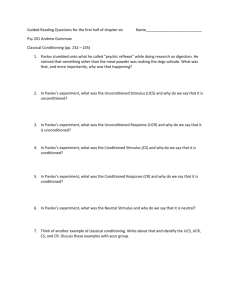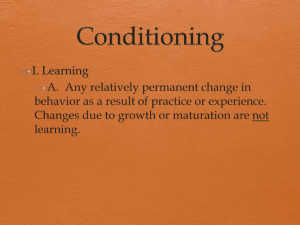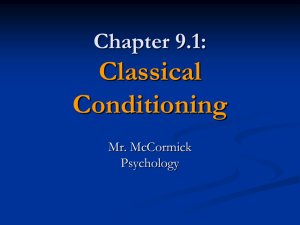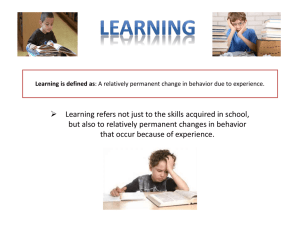What is learned in classical conditioning?
advertisement
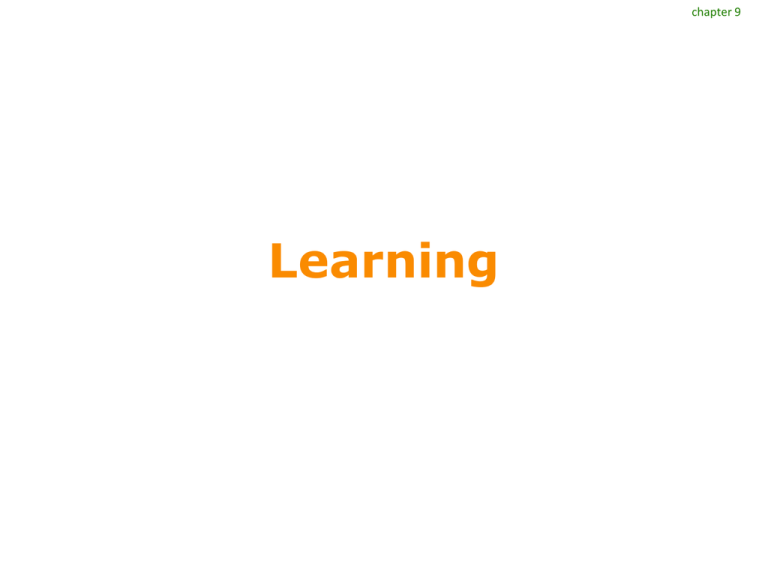
chapter 9 Learning chapter 9 Overview Classical conditioning Classical conditioning in real life Operant conditioning Operant conditioning in real life Learning and the mind chapter 9 Watson’s extreme environmentalism “Give me a dozen healthy infants, well-formed, and my own special world to bring them up in, and I’ll guarantee to take any one at random and train him to be any type of specialist I might select—doctor, lawyer, artist, merchant-chief, and yes, beggar-man and thief, regardless of his talents, penchants, tendencies, abilities, vocations, and race of his ancestors.” chapter 9 Definitions Learning A relatively permanent change in behavior due to experience Behaviorism An approach to psychology that emphasizes the study of observable behavior and the role of the environment as a determinant of behavior Conditioning The association between environmental stimuli and the organism’s responses objectives • Describe learning and compare and contrast behavior and cognitive learning • Summarize who Ivan PAVLOV IS • Create Pavlov's experiment using acronyms • List (4) principals of Classical conditioning Learning definition • A process through which experience produces a lasting change in behavior or mental process. • First- needs a lasting change • See a needle then get injection. • Next time you see a needle, expect pain= learned • Second how can you tell mental process? Behavioral Learning vs. Cognitive Learning • Behavioral Focus only on observable stimuli and responses • Cognitive- Hidden mental processes with behavior Ivan Pavlov 1849-1936 Pavlov info • Does not like structuralism and functionalists • Nobel Prize winner, dietician before training • Was working on digestion then began researching salivation • Found dogs would salivate BEFORE food got to their mouths. Or just hearing footsteps of lab assistants bringing food Essentials of Classical Conditioning • Pavlov focused on reflexes; blinking, salvation • Reflexive responses can be associated with new stimuli • FOR EXAMPLE: Pavlov rang a dinner bell then gave dog a bit of food • After a while dog would salivate from the bell Pavlov's first factor • Neutral stimulus- Light or bell • Paired with natural reflex-producing stimulus (food) Will produce a learned response chapter 9 Classical conditioning The process by which a previously neutral stimulus acquires the capacity to elicit a response through association with a stimulus that already elicits a similar response chapter 9 New reflexes from old Unconditioned stimulus (US) Elicits a response in the absence of learning Unconditioned response (UR) The reflexive response to a stimulus in the absence of learning Acquisition- Initial learning phase • Unconditioned Stimulus (US) stimulus that automatically provokes a reflexive responseFood • Unconditioned response ( UR)- Saliva • US-UR= Not learned chapter 9 New reflexes from old A neutral stimulus is then regularly paired with an unconditioned stimulus. chapter 9 New reflexes from old Conditioned stimulus (CS) An initially neutral stimulus that comes to elicit a conditioned response after being paired with an unconditioned stimulus Conditioned response (CR) A response that is elicited by the conditioned stimulus Occurs after the CS has been associated with the US Is usually similar to the US Classical Conditioning • Conditioned stimulus- (CS) Formally neutral stimulus. ( Tone or sound) • Salivation now a conditioned response (CR) chapter 9 Your turn You are visiting a house to see if you want to buy it. When you step through the front door, you are met with the smell of oatmeal chocolate chip cookies—just like your grandmother used to make. Suddenly you find yourself feeling that this house is a warm and friendly place. In this scenario, what is the CS? 1. 2. 3. 4. The smell of oatmeal chocolate chip cookies The new house Your grandma The feeling of warmth and friendliness chapter 9 Your turn You are visiting a house to see if you want to buy it. When you step through the front door, you are met with the smell of oatmeal chocolate chip cookies—just like your grandmother used to make. Suddenly you find yourself feeling that this house is a warm and friendly place. In this scenario, what is the CS? 1. 2. 3. 4. The smell of oatmeal chocolate chip cookies The new house Your grandma The feeling of warmth and friendliness chapter 9 Principles of classical conditioning Extinction Higher-order conditioning Stimulus generalization Stimulus discrimination chapter 9 Extinction The weakening and eventual disappearance of a learned response In classical conditioning, it occurs when the conditioned stimulus is no longer paired with the unconditioned stimulus. 1st principal of classical conditioning • Extinction- Occurs when a conditioned response is eliminated by repeated presentations of the CS (bell) without the UCS (food) • For example- you ring the bell then withhold the food. After time you stop salivating chapter 9 Higher-order conditioning A neutral stimulus can become a conditioned stimulus by being paired with an existing conditioned stimulus. Stimulus Generalization • If you fear spiders, you probably respond the same way to spiders of all sizes and markings • Pavlov’s dogs responded the same to different sounding bells Discrimination Learning • Occurs when an organism learns to respond to one stimulus but not the stimuli that are similar • For example you salivate when you hear Ice Cream Truck bell. HOWEVER you do not salivate at the door bell ringing. • Pavlov used tones with different frequencies chapter 9 Stimulus discrimination The tendency to respond differently to two or more similar stimuli In classical conditioning, occurs when a stimulus similar to the conditioned stimulus fails to evoke a conditioned response chapter 9 What is learned in classical conditioning? For classical conditioning to be most effective, the stimulus to be conditioned should precede the unconditioned stimulus. We learn that the first stimulus predicts the second. Summary • • • • Learning terms Pavlov Experiments Principals

